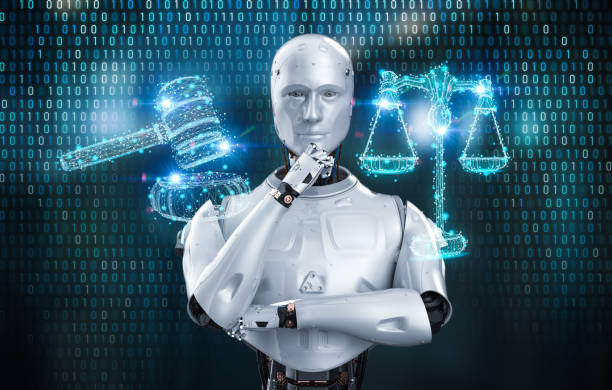Introduction
In the fast-paced world of intellectual property (IP) law, where innovation is the driving force behind economic growth, the need for efficient and streamlined legal processes has never been more crucial. As the volume of intellectual property filings continues to rise, legal professionals face the challenge of managing complex cases, conducting thorough research, and ensuring timely responses. In this landscape, automation emerges as a powerful tool, offering the potential to revolutionize the way IP legal processes are conducted. This blog explores the multifaceted role of automation in streamlining IP legal processes, examining its impact on efficiency, accuracy, and overall effectiveness.

Understanding the Complexity of IP Legal Processes
Intellectual property encompasses a broad spectrum of rights, including patents, trademarks, copyrights, and trade secrets. Each category involves intricate legal frameworks, requiring detailed documentation, thorough research, and precise analysis. Traditional manual methods of handling these processes are not only time-consuming but also prone to human errors. Automation, however, introduces a paradigm shift by leveraging technology to perform routine tasks, allowing legal professionals to focus on higher-value activities.
1. Automated Patent Search and Prior Art Analysis
One of the most time-consuming tasks in IP law is conducting patent searches and analyzing prior art. Automation streamlines this process by utilizing advanced algorithms and machine learning to sift through vast databases of patents and scientific literature. Automated tools can quickly identify relevant prior art, saving valuable time for legal professionals. Additionally, these tools can provide in-depth analysis, helping lawyers make more informed decisions about the patentability of an invention.
2. Efficient Trademark Screening and Clearance
Trademark clearance involves ensuring that a proposed trademark is not already in use or registered by another party. Automation simplifies this process by automating trademark searches, instantly flagging potential conflicts. This not only accelerates the clearance process but also minimizes the risk of unintentional trademark infringement. Automated tools can also provide comprehensive reports, aiding legal professionals in making well-informed decisions about the registrability of a trademark.
3. Streamlined Patent Application Drafting
Drafting a patent application requires precision and adherence to specific legal guidelines. Automation can assist legal professionals by generating drafts based on predefined parameters. While human expertise is still essential for crafting nuanced and comprehensive applications, automated tools can significantly reduce the time and effort involved in the initial drafting stages. This allows legal professionals to focus on strategic aspects of the application, enhancing the overall quality of submissions.
4. Enhanced Portfolio Management
For organizations with extensive IP portfolios, managing and maintaining a comprehensive database can be a daunting task. Automation comes to the rescue by offering solutions for efficient portfolio management. These tools can automate routine administrative tasks, such as updating deadlines, tracking renewals, and generating reports. By centralizing and automating these processes, legal professionals can ensure that their organization’s IP portfolio remains up-to-date and in compliance with regulatory requirements.
5. Automated Legal Research
Legal research is a fundamental aspect of IP law, requiring exhaustive examination of case law, statutes, and regulations. Automation in legal research involves the use of AI-powered tools that can quickly analyze vast amounts of legal data, extract relevant information, and provide actionable insights. This not only expedites the research process but also ensures that legal professionals have access to the most up-to-date information, enabling them to make well-informed decisions.
Challenges and Considerations in Implementing Automation for IP Legal Processes
While the integration of automation in intellectual property (IP) legal processes holds immense promise for increased efficiency and accuracy, it is essential to recognize and address the challenges and considerations associated with its implementation. As legal professionals explore the transformative potential of automation, they must navigate through various hurdles to ensure the ethical, legal, and secure use of these technologies.
1. Privacy Concerns and Data Security
Automation in IP legal processes often involves handling sensitive and confidential information, including proprietary technologies and trade secrets. Protecting the privacy of clients and safeguarding intellectual property data is paramount. Legal professionals must carefully vet automation tools, ensuring that they comply with industry standards for data security and privacy. Robust encryption, secure storage, and clear data access controls are imperative to mitigate the risk of unauthorized access or data breaches.
2. Algorithmic Bias and Fairness
The algorithms powering automation tools are only as unbiased as the data they are trained on. Concerns about algorithmic bias have gained prominence in various industries, and the field of IP law is no exception. Biases within algorithms can result in unfair outcomes, potentially impacting decisions related to patentability, trademark clearance, or legal research. Legal professionals must critically assess and continuously monitor the algorithms used in automation tools to identify and rectify any biases, ensuring fairness and equity in decision-making processes.
3. Ethical Considerations in Legal Practice
The ethical considerations surrounding the use of automation in legal practice are multifaceted. Legal professionals must grapple with questions related to the delegation of tasks to machines, the potential for job displacement, and the ethical responsibility of overseeing automated processes. Maintaining transparency in communication with clients about the use of automation, as well as establishing ethical guidelines for the responsible use of technology, becomes crucial to uphold the integrity of legal practice.
4. Integration with Human Expertise
While automation can significantly streamline routine tasks, it is not a substitute for human expertise. Legal professionals must strike a balance between leveraging automation for efficiency and retaining the critical human elements of judgment, creativity, and strategic thinking. Integrating automation as a complementary tool rather than a replacement requires careful planning and ongoing training to ensure that legal professionals can effectively collaborate with automated systems.
5. Regulatory Compliance Challenges
The legal landscape is continually evolving, with regulations and standards that vary across jurisdictions. Implementing automation in IP legal processes requires a deep understanding of the regulatory environment to ensure compliance. Legal professionals must stay abreast of changes in laws and regulations governing data protection, intellectual property, and technology to adapt automation processes accordingly.
6. Initial Costs and Return on Investment (ROI)
Implementing automation in IP legal processes may involve significant upfront costs, including the acquisition of software, training programs, and potential adjustments to existing workflows. Legal professionals must carefully evaluate the anticipated return on investment, considering both short-term gains in efficiency and long-term benefits such as improved client satisfaction, reduced errors, and enhanced competitiveness.
7. Resistance to Change and Training Needs
Adopting automation requires a cultural shift within legal organizations, and resistance to change is a common challenge. Legal professionals may be accustomed to traditional workflows and may feel apprehensive about embracing new technologies. Effective change management strategies, including comprehensive training programs and clear communication about the benefits of automation, are crucial to overcoming resistance and ensuring successful implementation.

The Future of Automation in IP Law: Navigating the Next Frontier
As technology continues to advance at an unprecedented pace, the future of intellectual property (IP) law is on the brink of a transformative era. Automation, powered by artificial intelligence (AI) and machine learning, is poised to redefine the landscape of IP legal processes. This section explores the emerging trends and possibilities that herald the future of automation in IP law.
1. Predictive Analytics for Strategic Decision-Making
The integration of predictive analytics into IP legal processes promises to revolutionize strategic decision-making. By leveraging historical data, machine learning algorithms can predict potential outcomes of legal cases, identify trends in patent and trademark filings, and offer valuable insights into the competitive landscape. Legal professionals can use this foresight to make informed decisions, allocate resources more efficiently, and devise proactive IP strategies.
2. Natural Language Processing (NLP) for Enhanced Legal Research
Natural Language Processing, a subset of AI, enables machines to understand and interpret human language. In the context of IP law, NLP can significantly enhance legal research by improving the speed and accuracy of information retrieval. Advanced algorithms can analyze vast amounts of legal texts, judgments, and scholarly articles, providing legal professionals with precise and relevant information. This not only expedites the research process but also ensures that legal teams have access to the most comprehensive and up-to-date data.
3. Blockchain Technology for IP Management
The use of blockchain technology holds great promise in the realm of IP management. Blockchain’s decentralized and secure nature can provide a tamper-proof ledger for recording and managing IP assets. Smart contracts, executed on blockchain platforms, can automate various aspects of IP transactions, such as licensing agreements, royalty payments, and transfer of ownership. This not only reduces the risk of fraud but also streamlines the administrative aspects of managing extensive IP portfolios.
4. Enhanced Patent Prosecution with Automation
The patent prosecution process, from filing to grant, involves numerous steps that can benefit significantly from automation. AI-powered tools can assist in drafting patent applications, optimizing claims, and even predicting potential challenges during examination. Automated workflows can streamline communication with patent offices, improving the efficiency of the prosecution process. As machine learning algorithms continue to evolve, they may also aid in predicting the likelihood of success in patent litigation, guiding legal professionals in strategic decision-making.
5. Collaboration between Humans and Machines
The future of automation in IP law is not about replacing human expertise but rather fostering collaboration between legal professionals and intelligent machines. Automated tools can handle repetitive tasks, allowing legal professionals to focus on higher-order thinking, creativity, and client engagement. Successful integration of automation requires a mindset shift, with legal professionals viewing AI as an invaluable ally in augmenting their capabilities rather than a threat to job roles.
6. Global Collaboration and Standardization
As businesses operate on a global scale, IP law is becoming increasingly complex, with the need to navigate diverse legal systems and regulations. Automation can facilitate global collaboration by providing standardized processes for IP management. Common platforms powered by automation can enable seamless communication and data exchange across borders, fostering a more interconnected and efficient global IP ecosystem.
7. Continuous Adaptation to Legal and Technological Changes
The future of automation in IP law is intrinsically tied to its ability to adapt to evolving legal frameworks and technological advancements. Legal professionals must stay vigilant, continuously updating their knowledge and embracing new technologies. Proactive engagement with regulatory changes and advancements in automation tools ensures that IP legal processes remain at the forefront of innovation.
Conclusion
The integration of automation in IP legal processes represents a transformative shift in the way legal professionals approach their work. By automating routine tasks, legal professionals can allocate more time and resources to strategic, high-value activities, ultimately improving the overall quality and efficiency of IP legal services. While challenges exist, the potential benefits of automation in streamlining IP legal processes are too significant to ignore. As we navigate the future of intellectual property law, embracing and harnessing the power of automation will be essential for staying ahead in a rapidly evolving legal landscape.

Leave a Reply